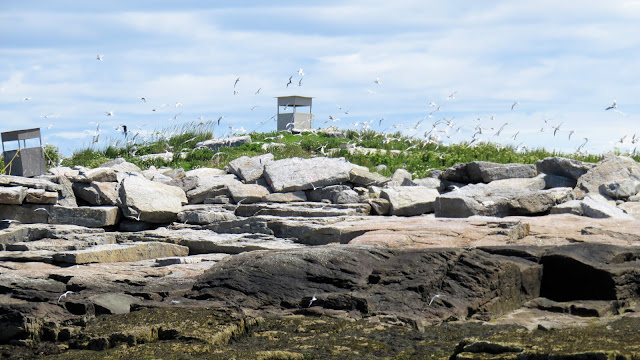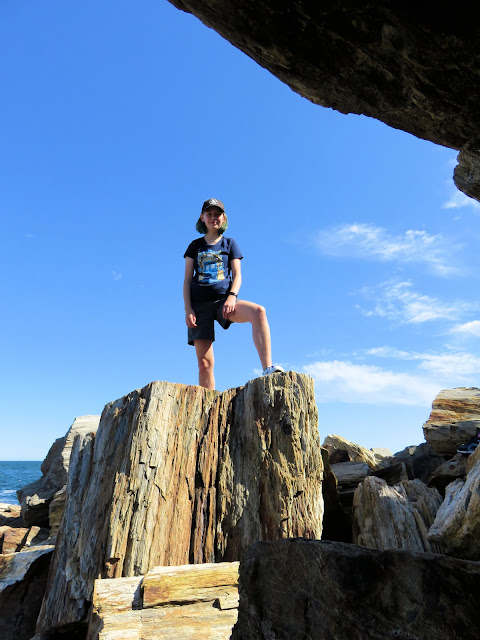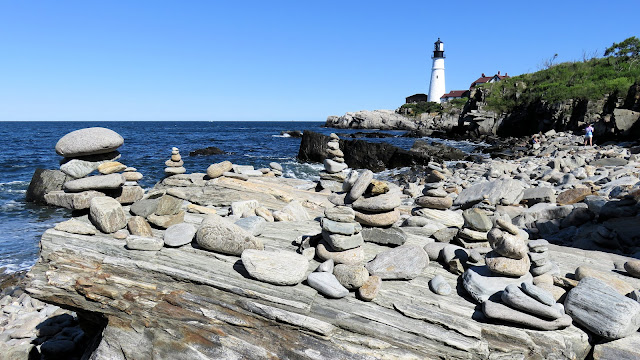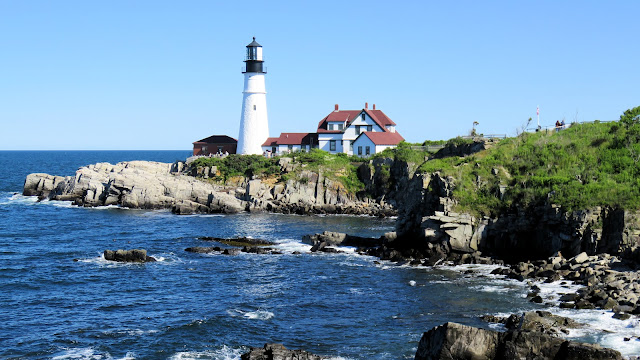Puffin Cruise
On the morning of June 20, all six of us departed aboard the Pink Lady II for a cruise to Eastern Egg Rock, a tiny, treeless island off the Maine coast. It was once home to a flourishing colony of puffins until hunters wiped them out in 1885.
 |
| Our tour boat, the Pink Lady II, photographed 23 June 2022. |
 |
| McFarland Island in Boothbay Harbor. |
Project Puffin was started in 1973 by the National Audubon Society as an initiative to repopulate the decimated puffin colonies off the Maine coast. It was spearheaded by Dr. Stephen Kress who had his first success on Eastern Egg Rock.
 |
| Boothbay Harbor. |
Our guide, a college intern named Arden, provided the background on Project Puffin as we motored out of Boothbay Harbor and east toward Eastern Egg Rock. She also ran through a number of bird identification cards to help us distinguish puffins from terns, cormorants, and other sea birds.
 |
| View of the Bristol Shipyard (our house is barely visible, too) from the Pink Lady II. |
Puffins live approximately 20-30 years, generally mate for life, and hatch a single offspring each year. They are imprinted by the location in which they are raised and generally return to the same spot to breed and nest. However, puffins also expect to nest within a thriving colony. Absence of an active puffin colony could imply that a location is no longer safe.
 |
| Burnt Island Lighthouse. |
Thus, Kress had two issues to overcome. No puffins were being born or imprinted on Eastern Egg Rock. And, if any were, returning puffins would ultimately avoid the depopulated island.
 |
| Ram Island Lighthouse, so-named because rams were once quarantined there to control sheep breeding. |
In 1973, Kress brought six puffin chicks from Newfoundland to Eastern Egg Rock in an attempt to re-establish the colony. Once they were strong enough to leave on their own, Kress needed to wait 3-4 years for the puffins to reach breeding age and return to nest. Four years came and went without any nests established. Realizing how deserted Eastern Egg Rock was, the researchers placed wooden puffin effigies all over the island to give it the appearance of a happening, hip kind of place for puffins to be. Still, nesting puffins shunned the island. The secret sauce for success: mirrors. Imprinting brought the puffins back to Eastern Egg Rock, wooden puffin decoys encouraged them to land, and mirrors provided enough illusion of an interactive colony that the puffins stayed to nest.
 |
| Eastern Egg Rock |
In 1981, the project finally bore fruit. (Fat beaked, adorable, flying fruit.) Four pairs of puffins returned and nested on Eastern Egg Rock after a 96 year absence. Since then, Eastern Egg Rock has become a thriving seabird colony for not only puffins, but eider, cormorants, terns, and various gulls.
 |
| Eastern Egg Rock is the most desolate thing I've seen this side of the Hebrides. |
It's a really cool story, a great example of how crazy ideas can work out, and an impressive accomplishment. The techniques developed on Eastern Egg Rock have now been used around the world to repopulate seabird populations.
 |
| A gull chilling on the shore of Eastern Egg Rock. |
The barren island remains an active research site where Audubon scientists spend summers studying the birds and their development. Evidently, some of the terns are rather aggressive and tend to divebomb researchers and aim projectile feces at them. (Laser guidance evidently not required.) This requires island staff to wear so-called "poop shirts" for protection. Life on the hardscrabble rock is not a cushy gig. But the birds seem to like it.
For my part, I am delighted that my work does not necessitate poop shirts. Except, perhaps, metaphorically.
Puffins are not large birds and not necessarily easy to spot, but they were plentiful around the island.
The puffin cruise was a great time. The story of Project Puffin both intrigued and inspired, the thriving bird colony was a wild hive of activity, and the sights along the Maine coastline beautiful. It was 100% worth the sunburns received.
 |
| A gull catches a thermal over Eastern Egg Rock. |
 |
| Finally! Puffins! |
Puffins are not large birds and not necessarily easy to spot, but they were plentiful around the island.
 |
| More puffins! |
I learned that it takes a lot more skill to operate a camera with a zoom lens from a boat on the water than it does from an airplane. In the water, both the subject and the photographer tend to move in different directions.
 |
| Cleared for take-off, westbound. |
 |
| A family of duck-like eider. The male is the distinctively-colored bird playing tail-end Charlie. |
On our voyage, we passed the Pemaquid Point Lighthouse that we visited in 2015. Of course, The Bear's fondest memory of that excursion had nothing to do with the lighthouse itself. She focused on climbing around on the rocky shore. I have often said that The Bear was part mountain goat. I resolved to find more rock scrambling opportunities for The Bear while we were in Maine. (Foreshadowing.)
 |
| Ram Island Lighthouse, again. |
 |
| A close-up on the Ram Island Lighthouse itself. |
 |
| Return to active Boothbay Harbor. |
 |
| The Bear and Izzy were quite pleased with the puffin cruise. |
Fake Agents of S.H.I.E.L.D.
When the series Agents of S.H.I.E.L.D. introduced the secret base known as the Lighthouse, the producers had a problem. Supposedly set on the Lake Ontario shore in Upstate New York, there were no sufficiently impressive lighthouses on actual Lake Ontario to adequately represent the fictional location.
 |
| Portland Head Lighthouse on Cape Elizabeth. |
Instead, they used images of the iconic Portland Head Lighthouse on Cape Elizabeth. It is quite possibly Maine's best recognized lighthouse. I generated some enthusiasm for an excursion there by sharing two things with Izzy and The Bear. First, I explained that there was a S.H.I.E.L.D. tie-in that they would learn about in a later season. Second was a promise that there would be rocks to clamber over.
Personally, I just wanted to see one of the most iconic lighthouses of the northeast.
The Portland Head Light was completed in 1791, the first of many lighthouses commissioned by the federal government following passage of the Lighthouse Act of 1789. This legislation was passed during the Washington administration by our nation's first congress as its first act of public works.
After briefly acknowledging the existence of the lighthouse, the girls immediately went in search of a path to the rocky shoreline. They found one in short order.
Somehow, The Bear seems to have temporarily sprouted bunny ears. I am not sure how this happened as they were not present later that evening when I inspected her head. But the photographs are unaltered and clearly do not lie.
The rocky shoreline was far more dramatic than what The Bear enjoyed at Pemaquid Point seven years ago.
The rugged coast also supplied an interesting framing device for lighthouse photos.
I was disappointed that the iconic lighthouse was smaller than I expected. Here, I present incontrovertible evidence that it is no taller than Mark.
 |
| Photo by Mark. |
Meanwhile, the girls continued to range ever farther away. Parts of the rocky coast actually resembled petrified wood in color and texture.
Once upon a time, I never would have dreamed that The Bear would ever forgo an opportunity to reenact the presentation of newborn Simba on Pride Rock from The Lion King. I guess my Little Bear is growing up. Maybe all that eye rolling should have clued me in.
Few things annoy my kid more than litterbugs. To her credit, she carried that clear PET McDonald's cup all the way back to the lighthouse for proper disposal.
I would have given anything to have found a way into the secret underground S.H.I.E.L.D. bunker to activate that Patrick "Rick Stoner" Warburton recording: "Welcome to the Lighthouse, the world's last bastion against the encroaching darkness. If you're here, you understand the gravity of the situation. The world as we know it has come to an end." But, no joy. Still, climbing around on the rocks was fun.
That's my Bear!
The Portland Head Lighthouse is really just beautifully set on the rugged coast. I took something on the order of 50 photographs of it. They are all pretty great, which I attribute more to the subject than the photographer.
Visible in the harbor from the Portland Head Light is the Ram Island Ledge Lighthouse. This should not be confused with the Ram Island Lighthouse that we saw near Boothbay Harbor that morning. The opportunity for confusion is obvious as there are evidently twenty-one Ram Islands in Maine. (This would seem to imply great numbers of horny sheep in the region.) This lighthouse marks a dangerous, rocky ledge at the entrance to the harbor. While still active as a navigational aid, it is currently privately owned and accessible only by boat.
Old School Battery
Near the Portland Head Lighthouse in Fort Williams Park is the 1905 Erasmus Keyes Battery. It was constructed to protect a minefield placed in the main waterway during wartime.
Guns, range finding equipment, and a powerful search light were all stripped from the site long ago, leaving behind a concrete canvass for graffiti. We climbed around it, locating massive bolts set in concrete pads that once anchored heavy, rapid fire guns. The Keyes Battery was manned throughout World War II and would have fired on any unauthorized ships entering the channel.
Wherever we go, that darn troll seems to follow. For years now...
Frankly, the fact that this fifteen year old still gleefully participates as a subject in these ridiculous troll photographs delights me to no end.
Fire Sale Property
The 1858 Goddard Mansion, built for local businessman and Civil War colonel John Goddard (1811-1870), lurks among the trees just beyond the Portland Head Light.
After Goddard's death, the US Army acquired the mansion in the late 19th century and used it to house married enlisted men with their families at Fort Williams. The basement of the mansion became the fort's Non-Commissioned Officer's Club.
With the closure of Fort Williams in 1962, the Army abandoned the mansion and it was acquired by the City of Portland. By that time, the interior had deteriorated to a point where the property was essentially unusable.
The city's unique solution to this problem was to conduct a controlled burn in the 1980s that left nothing but the stone shell of the mansion standing.
The shell of the once grand mansion remains to this day with the interior fenced off since 2009. Portions of the stone walls are tied to surrounding trees with cables to stabilize them. The ruins remain as a haunting reminder of times long past.
The ruin also seems like an odd thing for the city to perpetuate in a public park. Nanny states like New York would never allow something like this to exist, especially considering that the interior of the ruins remained accessible two decades after the fire!
A Full Day
 |
| A grumpy Bear waits to be seated at the Tuscan Bistro in Freeport, ME. |
Monday was a very full day for all of us between the puffin cruise to Eastern Egg Rock and exploration of Fort Williams Park, the Portland Head Light, and the rocky coast. By the time we arrived at the Tuscan Bistro for dinner, The Bear's tolerance for being photographed was obviously worn down to nothing.
Perhaps she was disappointed at not encountering any denizens of Tatooine at something called the Tuscan (i.e., Tusken) Bistro. She has always wanted her own gaffi stick. While there were no Tuskens at the Tuscan Bistro, the pizza was nonetheless tasty.


































No comments:
Post a Comment